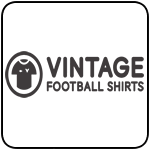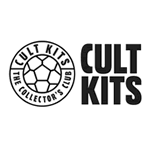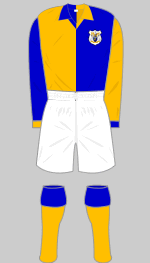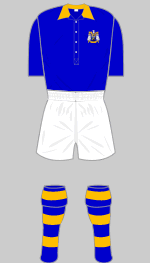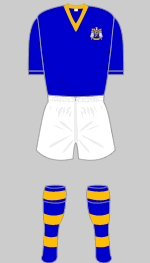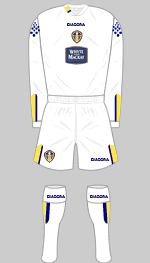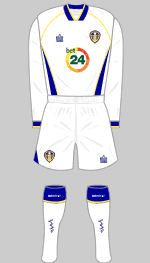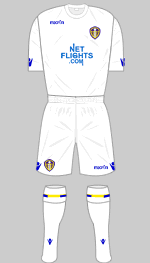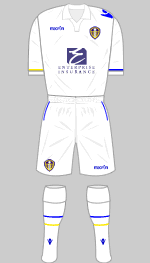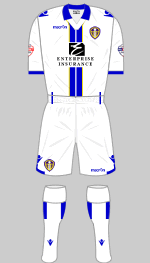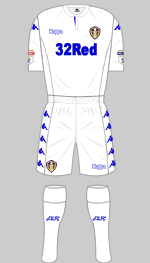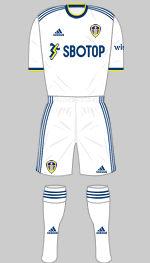Kit History

1919-1920 q
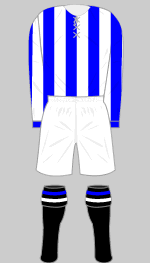
1920-1921 z
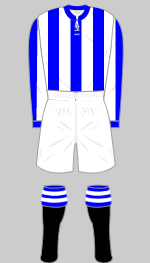
1920-1923 a q t

1923-1925 a f q

1925-1926 q

1926-1930 q t
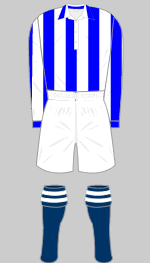
1930-1933 q

1933-Sept 1934 b q

Sept 1934-1935 x
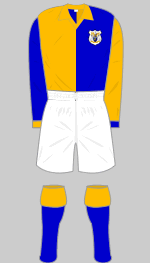
1935-1938 a q
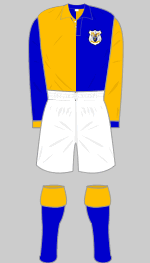
1939-1940 t
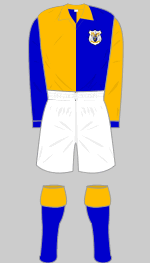
1944-1946 q t
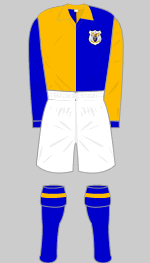
1946-1947 q

1947-1948 t

Aug-Sept 1948 t
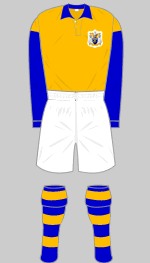
1949-1950 t y
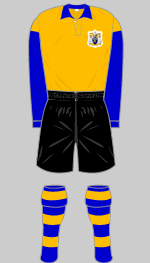
1950-1953 a f q t y

Sept 1960-1961 q
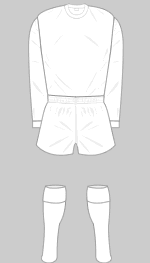
1961-1964 a

1964-1971 c

30 Aug 1967 t
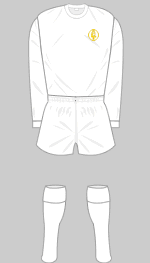
2 March 1968 v
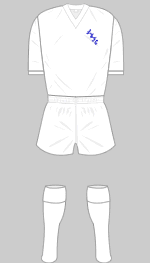
3 June 1971 w

1971-Feb 1972 c w

Feb 1972-1973 1 s w

Feb 1972-73 2 c l s w

1972-1973 3 s w
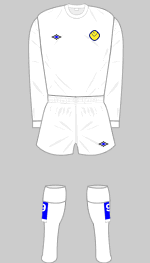
Aug-Dec 1973 r t w

Dec 1973-1974 c l w

Dec 1973-1974 alt t
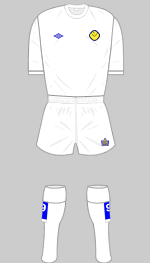
Dec 1973-1974 alt w
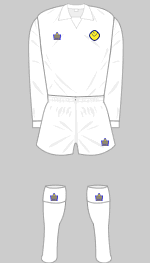
1974-1976 w

1980-1981 c m t

1981-1983 c g m o

1983-1984 g m p

1984-1985 g j m
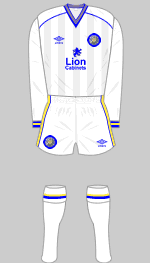
1985-1986 c m

1986-1988 c m

1988-1989 c h i m

1989-1990 i m

1990-1991 c k m t

1995-1996 c m t

1996-1998 c m

2003-2004 d k m

2005-2006 e m
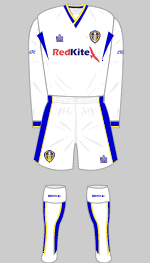
2007-2008 e
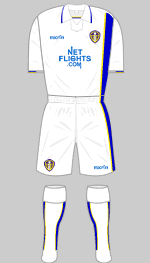
2009-2010 e
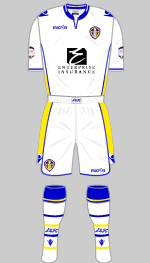
2012-2013 e
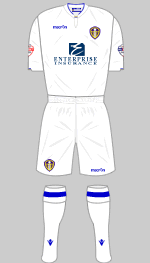
2014-2015 e
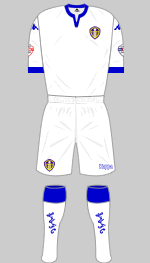
2015-2016 e
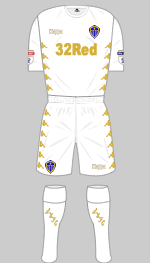
2017-2018 e
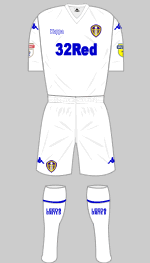
2018-2019 e
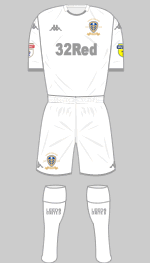
2019-2020 e

2020-2021 e
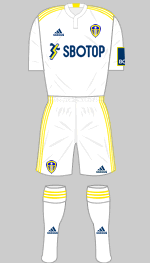
2021-2022 e
Background
 In October 1919 Leeds
City was compulsorily wound up by order of a joint FA and
Football League commission after the club refused to open its accounts
following allegations that it had illegally paid guest players during
the Great War. On the same day that City's assets were sold off Leeds
United was formed. The new club took over Leeds City Reserves' fixtures in the Midland
League and moved into Elland Road. The team wore black and white stripes in that inaugural season.
In October 1919 Leeds
City was compulsorily wound up by order of a joint FA and
Football League commission after the club refused to open its accounts
following allegations that it had illegally paid guest players during
the Great War. On the same day that City's assets were sold off Leeds
United was formed. The new club took over Leeds City Reserves' fixtures in the Midland
League and moved into Elland Road. The team wore black and white stripes in that inaugural season.
The chairman of Huddersfield Town, J Hilton Crowther, immediately proposed amalgamating the new club with Huddersfield and setting up the new operation at Elland Road. After an outcry in the Huddersfield press and some frantic fund-raising, the board and supporters of Huddersfield bought Hilton Crowther out, allowing him to take over Leeds United, who adopted the blue and white stripes of Huddersfield. This is a rare example of local rivals wearing identical kits.
There was considerable sympathy among rank and file League clubs for the plight of Leeds City (many of which had committed the same offence during the war but had not been caught) so it came as no surprise when United's application to join the expanded Second Division in 1920 was overwhelmingly supported by the clubs. Ironically, their first fixture was against Burslem Port Vale, who had taken Leeds City's place in the League the previous season. Leeds lost 0-2. In 1924 Leeds United won the Second Division championship and spent three seasons in Division One followed by relegation in 1931. They bounced back immediately and remained an undistinguished First Division side until immediately after the Second World War when they again dropped into Division Two.
 In September 1934, United adopted blue and old
gold as their colours, similar to those of Leeds City, with whom
they shared the nickname of "The Peacocks." Like that of their predecessor club, the new crest was based on the coat of arms of the city of Leeds and was worn until 1961, when the old colours were dropped. The owls were taken from the arms of Sir John Saville, Leeds' first alderman while the three stars are from the coat of arms of Leeds' first mayor, Sir Thomas Danby. The importance of wool in the economy of the region is signified by a fleece.
In September 1934, United adopted blue and old
gold as their colours, similar to those of Leeds City, with whom
they shared the nickname of "The Peacocks." Like that of their predecessor club, the new crest was based on the coat of arms of the city of Leeds and was worn until 1961, when the old colours were dropped. The owls were taken from the arms of Sir John Saville, Leeds' first alderman while the three stars are from the coat of arms of Leeds' first mayor, Sir Thomas Danby. The importance of wool in the economy of the region is signified by a fleece.
In 1955 the remarkable John Charles led United back into the First Division with 29 goals in 42 games. Charles scored an astonishing 38 goals in 40 games the following season to take Leeds to a creditable eighth position but the club were forced to sell him to Juventus to raise funds after fire destroyed their West Stand in 1956-57. Without his inspiration on the pitch, United struggled and dropped back into Division Two in 1960.
It has long been accepted that Don Revie introduced Leeds' famous all-white strip when he was appointed manager in 1961 but research by Martin Jarred and Malcolm MacDonald has established that under Jack Taylor, the team turned out at Elland Road on 17 September 1960 in their white change shirts with their usual white shorts. This became their first choice strip for the rest of the season.
In 1961 the Don Revie took over as as player/manager.
His radical vision was to transform the underachieving
club into the Real Madrid of Yorkshire. Out went the old blue and gold
and in came an all white strip. Although it seemed an act of arrogance
at the time, it was all part of Revie's plan to make everyone believe
that 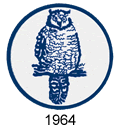 Leeds United were not just another make-weight club side. It was perhaps a measure of local cynicism (or "common sense" as they say in Yorkshire) that this radical change of strip was met with indifference. At first the new strip was worn without adornment but in 1964 a badge, featuring an owl was introduced.
Leeds United were not just another make-weight club side. It was perhaps a measure of local cynicism (or "common sense" as they say in Yorkshire) that this radical change of strip was met with indifference. At first the new strip was worn without adornment but in 1964 a badge, featuring an owl was introduced.
Revie's regime made Leeds a major club in domestic
and European competition. They stormed back into Division One in 1964
with an uncompromisingly physical style that won few friends. He then
built sides capable of playing sublime football but which all too often
 cracked under pressure. In Revie's ten year reign, Leeds won two League championships,
one FA Cup and one League Cup. (In the 1968 League Cup win, the club's first major trophy, the blue owl crest was rendered in gold.) They were runners-up five times in Division One.
"Super Leeds" introduced all sorts of gimmicks including coloured number tags attached to the players' stockings and, during the 1973-74 season, players could choose shirts with various collar styles and with long or short sleeves. In fact, no fewer than six variants could appear on the pitch in the same match. Revie also
cracked under pressure. In Revie's ten year reign, Leeds won two League championships,
one FA Cup and one League Cup. (In the 1968 League Cup win, the club's first major trophy, the blue owl crest was rendered in gold.) They were runners-up five times in Division One.
"Super Leeds" introduced all sorts of gimmicks including coloured number tags attached to the players' stockings and, during the 1973-74 season, players could choose shirts with various collar styles and with long or short sleeves. In fact, no fewer than six variants could appear on the pitch in the same match. Revie also  signed a contract with Admiral, a brand new sportswear firm, to produce branded kits that could be sold as replicas to supporters.
signed a contract with Admiral, a brand new sportswear firm, to produce branded kits that could be sold as replicas to supporters.
In 1973 an enigmatic new badge was introduced, which became known as the "smiley crest." It took considerable imagination and a cricked neck to see that the two yellow segments are highly stylised versions of the letters "L" and "U".
When Revie left to
manage the English national side in 1974, the board appointed Brian Clough as
manager. Clough, an outspoken critic of Revie's methods had previously described the Leeds' players as cheats and further alienated the team by bringing in several players from his  former club, Derby County. He was forced out after 44 days
in the job (the settlement he received gave him financial security for life). Jimmy Armfield took his place, sold off all the players Clough
had brought in and took the club to the European Cup Final in 1975.
former club, Derby County. He was forced out after 44 days
in the job (the settlement he received gave him financial security for life). Jimmy Armfield took his place, sold off all the players Clough
had brought in and took the club to the European Cup Final in 1975.
 In 1976 a mirror image of the crest was used with the colours reversed out which made the "LU" conceit easier to see. This was dropped the following season and replaced with a new design that placed the (original) smiley badge inside a roundel bearing the club's name.
In 1976 a mirror image of the crest was used with the colours reversed out which made the "LU" conceit easier to see. This was dropped the following season and replaced with a new design that placed the (original) smiley badge inside a roundel bearing the club's name.
For the rest of the decade Leeds remained a strong side but did not challenge for honours. An impatient board replaced Armfield with Jock Stein but with supreme irony, he matched Clough's record of 44 days in the job before being persuaded to leave to manage the Scottish national team.
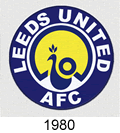 During the 1980s former "Super Leeds" players Allan Clarke, Eddie Gray and Billy Bremner all had a crack at managing the club, which dropped into the Second Division in 1982. The crest was redesigned twice during the decade: the first makeover in 1980 introduced a stylised peacock to the centre of the roundel (the club's nickname of "The Peacocks" is a hangover from the old days when blue and gold were their first choice colours). This
During the 1980s former "Super Leeds" players Allan Clarke, Eddie Gray and Billy Bremner all had a crack at managing the club, which dropped into the Second Division in 1982. The crest was redesigned twice during the decade: the first makeover in 1980 introduced a stylised peacock to the centre of the roundel (the club's nickname of "The Peacocks" is a hangover from the old days when blue and gold were their first choice colours). This 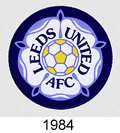 lasted until 1984 when it was replaced with an entirely new design based on the Yorkshire rose.
lasted until 1984 when it was replaced with an entirely new design based on the Yorkshire rose.
In 1988 Howard Wilkinson replaced Bremner as manager and guided United to the Division Two championship. Two seasons later, in 1992, United were crowned League champions for the third time. There followed a succession of high profile management appointments, dubious transfers and board room battles that eventually delivered the club into the hands of Peter Ridsdale.
Between 1997 and 2002 the club
never finished lower than fifth in the premiership while Ridsdale spent
money  as if it was water in an effort to secure success in Europe. To reflect this ambition, Ridsdale had the crest redesigned to a more "European style." this was adapted slightly a year later with the addition of a football behind the white rose.
as if it was water in an effort to secure success in Europe. To reflect this ambition, Ridsdale had the crest redesigned to a more "European style." this was adapted slightly a year later with the addition of a football behind the white rose.
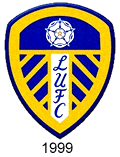 Leeds
came within a whisker of success but ultimately they failed and in 2004
they were relegated. The enormity of the debts run up by Ridsdale was
such that creditors were prepared to consider almost any alternative to
bankruptcy and after a protracted wrangle the club was sold. In the process
Leeds were forced to sell off every player of any value and faced oblivion.
In 2005, Ken Bates, the controversial one-time owner of Chelsea, bought the debt-ridden club.
Leeds
came within a whisker of success but ultimately they failed and in 2004
they were relegated. The enormity of the debts run up by Ridsdale was
such that creditors were prepared to consider almost any alternative to
bankruptcy and after a protracted wrangle the club was sold. In the process
Leeds were forced to sell off every player of any value and faced oblivion.
In 2005, Ken Bates, the controversial one-time owner of Chelsea, bought the debt-ridden club.
At the end of the 2006-07 season, United were relegated to League One (the third tier) for the first time in their history. In an attempt to clear their debts, the club went into administration just before the end of the season (the ten-point penalty now made no difference - a loop hole promptly removed during the close season) and Bates offered to buy the club back from the administrators, initially offering creditors a paltry 1p in the pound. Despite finding that Leeds had not complied with their strict insolvency policy, the Football League Board allowed the club to continue in membership albeit with a further 15 point penalty applicable in the 2007-08 season. Leeds almost overcame the disadvantage and reached the play-off final where they surprisingly lost to Doncaster.
Bates continued to court controversy and revealed to journalists that he was not in fact the owner of the club but he refused to reveal the identity of those in control, fuelling demands for greater transparency at at time when shady dealings were leading several clubs into dire trouble. In 2011 Bates retracted his statement, having presumably discovered that he did indeed, own the club.
After a strong campaign in the 2009-10 season Leeds finished as runners-up in League One to finally regain a place in the second tier.
On 21 December 2012, Bates sold his controlling interest to the Bahrein-based Gulf Finance House (GFH) who promptly put the club and its assets up for sale. A takeover bid from Sport Capital collapsed on January 30 2014 amid allegations that GFH had invited a last minute bid from Massimo Cellino, owner of the Italian club Cagliari and the following day the manager, Brian McDermott, was dismissed, apparently on the instructions of Cellino. As the Italian did not own the club at that point McDermott's dismissal was reversed and the Football League subsequently found that Cellino's convictions in the Italian courts for financial misdemeanours made him unfit to be a chairman. He was eventually permitted to join the club as president in May 2015.
Leeds became embroiled in a contractual dispute with their kit supplier, Macron, in 2015 and Kappa (who supplied Cellino's Cagliari club) were brought in. Their first strip was without short sponsorship due to a 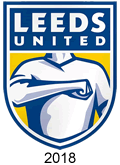 separate legal dispute with Enterprise Insurance.
separate legal dispute with Enterprise Insurance.
In 2017 Cellino sold his shares in the club to Italian businessman Andrea Radrizzani.
In February 2018 the club revealed a new crest to mark their centenary in 2019, provoking howls of outrage on social media. Over 10,000 people were apparently  consulted and the design was intended to "represent the passion and the unique identity that runs through the club" and depicts the "Leeds Salute." Within two hours 16,000 people had signed an online petition demanding that the new badge be withdrawn leading the club to announce there would be "a rethink" and the controversial design was dropped like a hot potato shortly afterwards. It was not until the new 2019-20 strip was released in July 2019 that the revised centenary crest was finally revealed.
consulted and the design was intended to "represent the passion and the unique identity that runs through the club" and depicts the "Leeds Salute." Within two hours 16,000 people had signed an online petition demanding that the new badge be withdrawn leading the club to announce there would be "a rethink" and the controversial design was dropped like a hot potato shortly afterwards. It was not until the new 2019-20 strip was released in July 2019 that the revised centenary crest was finally revealed.
After missing out on promotion in 2018-19 under new coach, Marcelo Bielsa, Leeds finished the 2019-20 season ten points clear at the top of the Championship, earning promotion to the Premier League after an absence of 16 years.
Sources
- (a) Mighty Mighty Whites excellent independent site with detailed history of both United and their predecessor, Leeds City compiled by Dave Tomlinson
- (b) Sheffield United FC (Images of Sport - Denis Clarebrough)
- (c) Sporting Heroes
- (d) empics
- (e) Leeds United Official Website
- (f) Football Focus
- (g) Bjørn-Terje Nilssen
- (h) Gerry Gafford
- (i) Paul Maroney
- (j) Pete's Picture Palace
- (k) David King
- (l) Alick Milne
- (m) True Colours 2 (John Devlin 2006)
- (n) Toffs
- (o) Mark Austen
- (p) Matty Hebditch
- (q) Leeds United FC History - a comprehensive site with a fine collection of team photos.
- (r) Steve Browne
- (s) Christopher Worrall
- (t) Keith Ellis (HFK Research Associate)
- (u) Leeds United: The Complete Record (Martin Jarred & Malcolm MacDonald 2012)
- (v) Brendan Staunton
- (w) Tony Sealey
- (x) Martin Hart
- (y) George Chilvers
- (z) Football & the First World War
Crests are the property of Leeds United AFC. Crest artwork by WAFLL. Photograph courtesy of Leeds United FC History (c) Neil Roche.
